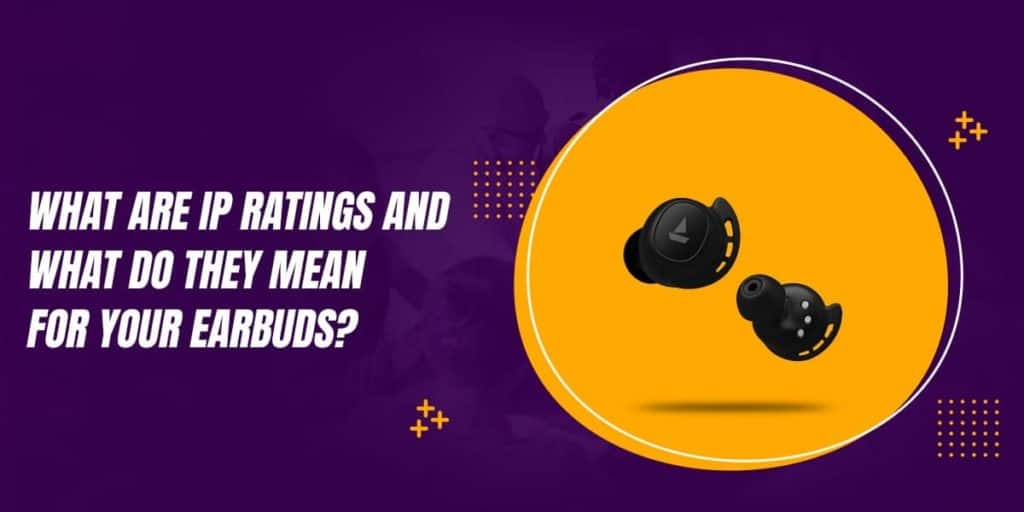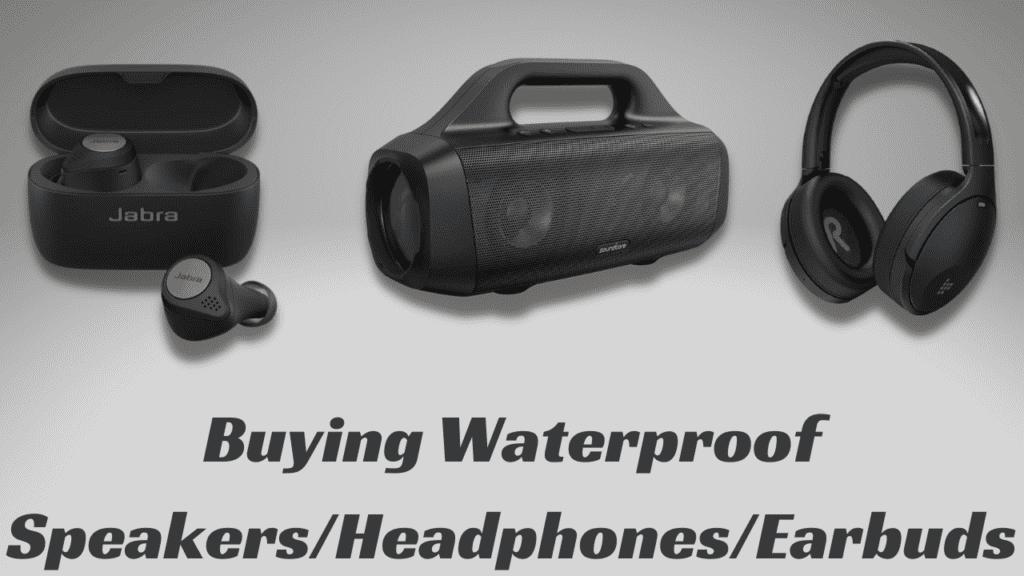Contents

Wanna know What Are IP Ratings? Read on to know more.
Wireless earbuds are some of the best things you can have, both for listening to music and watching movies. More often than not, you’ll find yourself taking them outside, even during rainy conditions.
So, it’s important that you know how to keep them safe from water, and that’s where you have to learn what an IP rating is. In this post, I’ll go into details about the different kinds of IP ratings and how much they can protect a pair of earbuds from environmental hazards
If you are looking to buy an outdoor speaker or sports headphones/earbuds and you did your research, you have probably seen some IPX rating in the specification list or on the box of the device you want to buy.
Most of today’s outdoor speakers and sports headphones/earbuds have at least an IPX4 rating and some even have IPX7 or IP67 ratings. In case you are not sure what those ratings mean, this short article will help you understand the purpose and meaning of each IP/IPX rating.
What is IPX Rating and Why is it Important?
IP stands for International Protection or, in some cases, Ingress Protection. IP (or IPX) rating is the marking that describes the level of protection (provided by the enclosure of the device) against dust, water, and ingress of other particles or fluids.
You can see the general form of the IP rating in the picture below. Each rating starts with the IP abbreviation followed by 2 or 3 numbers and/or letters.
When buying an outdoor speaker, sports headphones, or a waterproof/dustproof smartphone, you will probably see only two numbers or a letter and a number (something like IP67 or IPX7).
Each letter/number has its meaning and describes the level of protection against the ingress of certain particles/fluids.
The general form of an IP rating
The first digit/letter in the IP rating describes the level of protection against the ingress of solid particles and objects. If the device doesn’t offer any protection against the ingress of solid particles, the first symbol will be 0.
If there is no info on the level of protection against ingress of solid particles (if the device wasn’t tested), you will see the X letter instead of 0 as the first symbol after IP (something like IPX4 or IPX7).
This is what you can see in many product descriptions when looking for waterproof/water resistant/splashproof outdoor speakers and other electronic equipment.
There are 6 levels of protection against the ingress of solid particles. Level 5 and level 6 are desirable when buying outdoor speakers especially if you are going to use them on the beach.
If the first number after IP is 5, the device is dust-protected which means that it is not completely protected from the ingress of dust but even if the dust enters the device, the quantity will not be enough to interfere with the operation of the device.
If the first number after IP is 6, the device is dustproof/dust-tight and it is completely protected from the ingress of dust.
The second symbol in the IP rating describes the level of protection against water ingress (not against ingress of other fluids). There are 9 levels of water protection and we will explain them all in the next section.
If a device doesn’t offer any level of protection against water ingress, the second symbol in the IP rating will be 0 and if the device is not tested for water resistance, 0 is replaced with X.
The third symbol is optional and not all devices are tested for this rating. The third symbol is a letter (H, S, M, F, or W). These letters describe different conditions in which the device was tested and give you some important info about the device’s characteristics.
H stands for high voltage, M implies that the device was moving during the water test, S implies that the device was standing still during the water test, W stands for weather conditions, while F implies that the device is oil resistant.
The Meaning of Each IPX Rating
The water resistance rating is the most important thing you should be checking when buying an outdoor speaker, sports headphones/earbuds, or any other piece of waterproof/water resistant/splash-proof electronic equipment.
As we have already mentioned, there are 9 levels of water resistance and we will now go through all those levels and explain the amount of protection they represent.
For this article, we will assume that the device (speaker, headphones, earbuds) is not tested for dust resistance (the first symbol in the IP rating is X and the second describes the water resistance).
IPX1 – A device with a level 1 water resistance rating can survive drops of water falling vertically on it for 10 minutes. The amount of water corresponds to 1mm per min rainfall.
IPX2 – A device with a level 2 water resistance rating can survive drops of water falling on it while being tilted at a 15° angle. The device is tested 4 times (in four positions) and the amount of water corresponds to 3mm per min rainfall.
IPX3 – A device with a level 3 water resistance rating can survive sprays of water (sprayed by a nozzle with a counterbalanced shield approved by the IEC).
The water is sprayed at different angles up to 60° measured from the vertical axis. The pressure of the water is 50-150kPa and the amount of the sprayed water during 5min testing is 50 liters.
This is the moment when things get interesting. Most of the outdoor speakers and sports headphones/earbuds feature at least an IPX4 rating and they are often considered splash-proof.
IPX4 – A device with a level 4 water resistance rating can survive splashes of water from any direction. The same nozzle from the previous example can be used for this testing but the shield has to be removed. Some of the most popular speakers with the IPX4 rating are Bose Soundlink Revolve and VTIN.
IPX5 – A device with a level 5 water resistance rating can survive small water jets projected by a 6.3mm nozzle at any angle. The testing lasts for 15min and the volume of water is 12.5 l/min.
IPX6 – A device with a level 6 water resistance rating can survive strong water jets projected by a 12.5mm nozzle at any angle. The testing lasts for 3 min and the volume of water is 100 l/min.
Devices with the IPX5 and IPX6 ratings are considered water-resistant.
IPX7 – A device with a level 7 water resistance rating can survive (without any damage) immersion in water of up to 1m (approx. 3ft) for 30min. All the devices with the IPX7 rating are considered fully waterproof.
There’s a bunch of speakers/headphones with the IPX7 rating and the most popular are JBL Flip 4, JBL Charge 3, UE BOOM, etc.
IPX8 – A device with a level 8 water resistance rating can survive immersion in water deeper than 1m (usually up to 3m). The duration of testing is determined in cooperation with the manufacturer (there’s no predefined time but it’s usually longer than the testing time for the IPX7 rating).
IPX9K – A device with a level 9K water resistance rating can survive powerful water jets. High-temperature water (80°C/ 176°F) is used for testing and the device is sprayed from a close distance (0.1-0.15m). The water pressure is supposed to be high (8-10MPa) and the volume of sprayed water is 14-16 l/min.
Most of the outdoor speakers, sports headphones and earbuds, and waterproof/water resistant smartphones on the market have IPX4, IPX5, IPX6, and IPX7 ratings.
You can also find some earbuds, speakers, and protective phone cases with the IPX8 rating, while IPX9K is reserved for some other devices (cannot be found on audio equipment).
What to Look for When Buying Waterproof Speakers/Headphones/Earbuds

Now that you know what each symbol in the IP/IPX rating means, it’s not so difficult to guess what to look for. If you need a pair of sports earbuds, they need to be at least IPX4 certified.
Devices with an IPX4 rating are considered splash proof but some manufacturers also define their products (usually headphones and earbuds) as sweat resistant.
You should know that there is no such IP rating that can be described as ‘’sweat-resistant’’ and most of the products described as ‘’sweat-resistant’’ are, in fact, splash-proof (IPX4 certified).
If you want the best possible protection, you should be looking for an IPX7 rating (fully waterproof device) or even IP67 (fully dustproof, fully waterproof).
Even if a speaker is IPX7 certified, that doesn’t mean that it will float on water. That’s a completely different thing.
Two more things before the end. The fact that some device is IPX7 or IPX8 certified (fully waterproof and submersible in water) does not mean that it is IPX6 or IPX5 certified (it doesn’t have to be resistant to water jets).
IPX7 and IPX8 devices have to be additionally tested for IPX5 and IPX6 ratings. If they are tested for both, you will see an IPX rating written like this IPX6/IPX8.
Also, be careful when checking IP and IPX ratings – if there’s a hyphen between IP (or IPX) and the number, the rating is fake/invalid. So, if you see something like IPX-7 or IP-68, don’t trust the manufacturer. This is not a valid IP/IPX rating. It may be just a mistake but you should still be careful.
Frequently Asked Questions – What Are IP Ratings
Q: What are the IPX ratings?
A: IPX ratings describe the level of protection of a certain device against water ingress. In layman’s terms, it describes the waterproofness or water-resistance of a device.
The IPX mark is followed by a number 0-8 (0 – no protection at all, 8 – fully waterproof and submersible in the water of up to 3m/9ft depth).
The testing is done with fresh water – if the device is IPX7 or IPX8 rated, it doesn’t mean it can survive submersion in saltwater.
Also, if the device is IPX7 or IPX8 rated, it doesn’t mean it’s also IPX6 rated/certified (if it’s submersible in water, it’s not necessarily resistant to strong water jets).
Q: What is the best waterproof rating?
A: IPX6, IPX7, and IPX8 ratings offer the greatest level of protection against water ingress.
Depending on your needs, you should be looking for a different IPX rating. If you need something for swimming, then you need a device that’s submersible in water (IPX7 or IPX8).
Q: What does IPX7 rating mean?
A: A device with the IPX7 rating is fully submersible in the water of 1m/3ft depth for up to half an hour. This device will be fully functional after the submersion but it’s recommended to dry it off before use.
Q: Is the IP68 rating safe for swimming?
A: A device with an IP68 rating is fully dustproof and fully waterproof (submersible in the water of up to 3m depth for more than 30 minutes). So, yeah, the IP68 rating is perfectly safe for swimming.
However, if you have some Bluetooth headphones with the IP68 rating and a phone with the same rating and you want to use them for swimming, you may experience some issues.
The Bluetooth signal doesn’t react well to water and it may cut in and out even if the distance between your phone and headphones is less than 5ft.
Q: Can you swim and shower with IPX7?
A: Yes, you can. IPX7 rating implies that a device is fully waterproof and submersible in the water of up to 1m depth for 30mins.
A few splashes of water should not be a problem for a fully waterproof device. There are dozens of Bluetooth shower speakers with the IPX7 rating.
Q: Can you swim with AfterShokz Aeropex?
A: AfterShokz Aeropex bone-conduction headphones are IP67 certified. They are fully dustproof and waterproof, which makes them perfectly safe for swimming.
However, Aeropex headphones are Bluetooth headphones and the Bluetooth signal doesn’t travel through the water as well as it travels through air (the water molecules attenuate the Bluetooth signal).
So, the headphones will survive the water, but you are not going to enjoy wireless music.
If you want headphones that can play music while swimming, you should be looking for headphones with IP67/IP68 rating and with built-in storage. Something like AfterShokz Xtrainerz.
Q: What headphones do swimmers use?
A: Well, we don’t exactly know what type of headphones Michael Phelps and other members of the US team use (and we don’t think they use the headphone while swimming), but we can recommend you to look for headphones with IPX7 and IPX8 rating (preferably IP67 and IP68).
You should also be looking for headphones with a built-in battery and some kind of internal storage. Things like AfterShokz Xtrainerz or Sony NWWS413LM are great for swimming.
Some people also recommend H2O products (like SURGE Sportwrap+) but they are not as hassle-free as the previous two headphone models.
